A Novel Context-Aware Reliable Routing Protocol and SVM Implementation in Vehicular Area Networks
Abstract
1. Introduction
- Link Reliability: The probability of a connection remaining uninterrupted for a definite period of time is known as link reliability. Assumed a prediction time for constant accessibility of a dedicated link among the interconnection of the nodes at time , whereas is representing the link reliability.
- Route Reliability: In VANETs, various possible paths could occur between the sender node and the receiver nodes , where each path is the connection between various links in the dedicated route. For every provided path, the number of its established links by . The route reliability for path P is described as follows:where is the link reliability as calculated in Equation (1).
1.1. Research Contributions
- Introduces a context-aware method to distinguish the traffic flows with distinct context information to minimize communication overheads.
- Design a machine learning techniques-based routing that considers k-means and SVM approaches for optimal route selection to deliver reliability and robustness towards network malfunction, dynamic topology, and variable mobility in VANET.
- Adopts packet delivery ratio (PDR) and E2E delay as routing metrics which guarantee that the most reliable route is selected during transmission.
1.2. Organization
2. Background Survey
3. Approaches behind the Proposed Protocol
3.1. K-Means
- Find the optimal value for K by an iterative procedure.
- Allocates each data input to its nearby k-center and generates a cluster.
- A k-means algorithm recognizes influential nodes from each cluster with the probability of achieving energy-efficient transmission. In various modifications, the k-means groups the vehicles and selects any nodes in some rounds as CHs. It can decrease the amount of communicated messages from one node to another, saving the network more resources. A k-means clustering algorithm in which dynamic grouping by k-implies is performed that fits well with the vehicular network’s dynamic topology characteristics. The suggested clustering reduces overhead and traffic management. Therefore, every cluster contains data points with unities that do not belong to other clusters. So, the k-means clustering methods [37,38,39] have been utilized effectively to resolve various VANET issues. Firstly, k-means algorithm is presented for the clustering of nodes and then a dynamic routing protocol is implemented to obtain results of proposed routing protocols, which are compared with the results of existing techniques as represented in Section 4.
3.2. SVM
4. Mathematical Analysis for Proposed Protocol
- The likelihood that a direct connection among two vehicles will remain uninterruptedly accessible over a definite time duration is known as link reliability. Assumed a prediction time for constant accessibility of a particular link among two vehicles at , the link reliability is specified as below:
- For the proposed work, evaluation for the Euclidean distances among the data points and centroids are calculated to allocate points to the closest centroid. The dataset is generated based on the following parameters such as the location of the vehicle, the direction, the velocity of the vehicle, and the Point of Interest (POI).
- A process for clustering N data inputs into k clusters , each comprising data points, , reduces the subsequent mean-square-error (MSE) value:where xt is a vector signifying the tth input and cj signifies the geometric centroid of the cluster Ci. To minimize an objective value, a squared error function is used, which represents the distance between data point xt and the cluster center cj.
- 4.
- Set k cluster centers . For each input xt and k cluster, perform stages 2 and 3 until all clusters congregate.
- 5.
- Evaluate cluster membership value using Equation (4) and determine the membership of each input in every k cluster whose cluster center is nearest to that centroid.
- 6.
- For each k cluster, establish cj to be the center of all data inputs in cluster Ci.
- 7.
- Consequently, the k-means clustering divides the routes into two clusters named GOOD and BAD. The cluster with high mean square error (MSE) is labeled as BAD, and the cluster with low MSE is labeled as GOOD. Machine learning techniques are implemented to train the data accumulated from produced simulations and train SVM in every iteration with random inputs until the best results are achieved. The pseudo-code has been explained in Algorithm 1.
- 8.
- In this step, Radial Basis Function (RBF) is used for transforming the given input vector into n-dimensional data. Gaussian RBF mathematical expression is represented as follows:where, represents the kernel function for two classes c1 and c2, and represented .
- 9.
- After training the routing data with SVM, during the execution, we evaluate the following parameters of each route from source to target:
- PDR: It signifies the ratio of all packets effectively received at the receiver to all the data packets transmitted by the source vehicle.
- Average E2E delay: It signifies the average time that the packets take to reach the destination.
- Throughput: It signifies the total packets that are transferred from the sender to the receiver node in a given amount of time.
- 10.
- After determining the nodes which occur frequently in the non-optimal routes, the proposed approach eliminates the routes which consist of nodes from the BAD cluster and shifts the load of the malicious nodes to its nearby node to maintain reliability.
| Algorithm 1: K-means Clustering-based VANET Routing | |
| Input Parameters: | |
| (a) Set of Routes | |
| (b) Initial number of clusters | |
| (c) Direction, Velocity, and Location of each Vehicle node | |
| Output Parameters: | |
| (a) Optimal clusters: GOOD and BAD | |
| 1. | Randomly initialize centroids in space |
| 2. | For do |
| 3. | Calculate the cluster membership function |
| 4. | Assign routes to convenient clusters according to |
| 5. | End for |
| 6. | If all routes are assigned to a cluster, then |
| 7. | End of the algorithm |
| 8. | Else |
| 9. | |
| 10. | End if |
| 11. | If MSE of Cluster = Low, then |
| 12. | Cluster = GOOD |
| 13. | Else |
| 14. | Cluster = BAD |
| 15. | End if |
5. Simulation Analysis
6. Conclusions
Author Contributions
Funding
Institutional Review Board Statement
Informed Consent Statement
Data Availability Statement
Conflicts of Interest
References
- Nassar, L.; Jundi, A.; Golestan, K.; Sattar, F.; Karray, F.; Kamel, M.; Boumaiza, S. Vehicular ad-hoc networks (VANETs): Capabilities, challenges in context-aware processing and communication gateway. In International Conference on Autonomous and Intelligent Systems; Springer: Berlin/Heidelberg, Germany, 2012. [Google Scholar]
- Wahid, I.; Tanvir, S.; Ahmad, M.; Ullah, F.; AlGhamdi, A.S.; Khan, M.; Alshamrani, S.S. Vehicular Ad Hoc Networks Routing Strategies for Intelligent Transportation System. Electronics 2022, 11, 2298. [Google Scholar] [CrossRef]
- Zeadally, S.; Hunt, R.; Chen, Y.S.; Irwin, A.; Hassan, A. Vehicular ad hoc networks (VANETS): Status, results, and challenges. Telecommun. Syst. 2012, 50, 217–241. [Google Scholar] [CrossRef]
- Dhankhar, S.; Agrawal, S. VANETs: A survey on routing protocols and issues. Int. J. Innov. Res. Sci. Eng. Technol. 2014, 3, 13427–13435. [Google Scholar]
- Dua, A.; Kumar, N.; Bawa, S.; Rodrigues, J.J. An intelligent context-aware congestion resolution protocol for data dissemination in vehicular ad hoc networks. Mob. Netw. Appl. 2015, 20, 181–200. [Google Scholar] [CrossRef]
- Eiza, M.H.; Ni, Q.; Owens, T.; Min, G. Investigation of routing reliability of vehicular ad hoc networks. EURASIP J. Wirel. Commun. Netw. 2013, 2013, 1–15. [Google Scholar] [CrossRef]
- An, C.; Wu, C.; Yoshinaga, T.; Chen, X.; Ji, Y. A context-aware edge-based VANET communication scheme for ITS. Sensors 2018, 18, 2022. [Google Scholar] [CrossRef] [PubMed]
- Saleh, A.I.; Gamel, S.A.; Abo-Al-Ez, K.M. A reliable routing protocol for vehicular ad hoc networks. Comput. Electr. Eng. 2017, 64, 473–495. [Google Scholar] [CrossRef]
- Bao, X.; Li, H.; Zhao, G.; Chang, L.; Zhou, J.; Li, Y. Efficient clustering V2V routing based on PSO in VANETs. Measurement 2020, 152, 107306. [Google Scholar] [CrossRef]
- Zhang, X.; Zhang, X. A binary artificial bee colony algorithm for constructing spanning trees in vehicular ad hoc networks. Ad Hoc Networks 2017, 58, 198–204. [Google Scholar] [CrossRef]
- Abbas, F.; Fan, P. Clustering-based reliable low-latency routing scheme using ACO method for vehicular networks. Veh. Commun. 2018, 12, 66–74. [Google Scholar] [CrossRef]
- Adrian, R.; Sulistyo, S.; Mustika, I.; Alam, S. ABNC: Adaptive Border Node Clustering Using Genes Fusion Based on Genetic Algorithm to Support the Stability of Cluster in VANET. Int. J. Intell. Eng. Syst. 2020, 13, 354–363. [Google Scholar] [CrossRef]
- Rashid, S.A.; Audah, L.; Hamdi, M.M.; Alani, S.; Mohammed, A.H. A Survey on Multi-Objective Harmony Search-Based Clustering and Characteristics in WSN. In Proceedings of the IEEE 4th International Symposium on Multidisciplinary Studies and Innovative Technologies (ISMSIT), Istanbul, Turkey, 22–24 October 2020; pp. 1–5. [Google Scholar]
- Dutta, C.; Singhal, D. A Hybridization of Artificial Neural Network and Support Vector Machine for Prevention of Road Accidents in Vanet. Int. J. Comput. Eng. Technol. 2019, 10, 110–116. [Google Scholar] [CrossRef]
- Wu, J.; Fang, M.; Li, X. Reinforcement learning based mobility adaptive routing for vehicular ad-hoc networks. Wirel. Pers. Commun. 2018, 101, 2143–2171. [Google Scholar] [CrossRef]
- Ramalingam, M.; Thangarajan, R. Mutated k-means algorithm for dynamic clustering to perform effective and intelligent broadcasting in medical surveillance using selective reliable broadcast protocol in VANET. Comput. Commun. 2020, 150, 563–568. [Google Scholar] [CrossRef]
- Alsuhli, G.H.; Fahmy, Y.A.; Khattab, A. Bio-inspired metaheuristic framework for clustering optimisation in VANETs. IET Intell. Transp. Syst. 2020, 14, 1190–1199. [Google Scholar] [CrossRef]
- Burušić, A.; Balen, J.; Semialjac, K. Review and Analysis of Bio-Inspired Routing Protocols in VANETs. In Proceedings of the 2020 IEEE International Conference on Smart Systems and Technologies (SST), Osijek, Croatia, 14–16 October 2020; pp. 45–50. [Google Scholar]
- Azzoug, Y.; Boukra, A. Bio-inspired VANET routing optimization: An overview. Artif. Intell. Rev. 2021, 54, 1005–1062. [Google Scholar] [CrossRef]
- Bitam, S.; Mellouk, A.; Zeadally, S. Bio-inspired routing algorithms survey for vehicular ad hoc networks. IEEE Commun. Surv. Tutor. 2014, 17, 843–867. [Google Scholar] [CrossRef]
- Abuashour, A.; Kadoch, M. Performance improvement of cluster-based routing protocol in VANET. IEEE Access 2017, 5, 15354–15371. [Google Scholar] [CrossRef]
- Bitam, S.; Mellouk, A. QoS swarm bee routing protocol for vehicular ad hoc networks. In Proceedings of the 2011 IEEE International Conference on Communications (ICC), Kyoto, Japan, 5–9 June 2011; pp. 1–5. [Google Scholar]
- Bitam, S.; Mellouk, A.; Zeadally, S. HyBR: A hybrid bio-inspired bee swarm routing protocol for safety applications in vehicular ad hoc networks (VANETs). J. Syst. Archit. 2013, 59, 953–967. [Google Scholar] [CrossRef]
- Aravindhan, K.; Dhas, C.S.G. Destination-aware context-based routing protocol with hybrid soft computing cluster algorithm for VANET. Soft Comput. 2019, 23, 2499–2507. [Google Scholar] [CrossRef]
- Rana, H.; Thulasiraman, P.; Thulasiram, R.K. MAZACORNET: Mobility aware zone based ant colony optimization routing for VANET. In Proceedings of the 2013 IEEE Congress on Evolutionary Computation, Cancun, Mexico, 20–23 June 2013; pp. 2948–2955. [Google Scholar]
- Fekair, M.E.A.; Lakas, A.; Korichi, A. CBQoS-Vanet: Cluster-based artificial bee colony algorithm for QoS routing protocol in VANET. In Proceedings of the IEEE International Conference on Selected Topics in Mobile & Wireless Networking (MoWNeT), Cairo, Egypt, 11–13 April 2016; pp. 1–8. [Google Scholar]
- Chandren Muniyandi, R.; Hasan, M.K.; Hammoodi, M.R.; Maroosi, A. An Improved Harmony Search Algorithm for Proactive Routing Protocol in VANET. J. Adv. Transp. 2021, 6641857, 1–17. [Google Scholar] [CrossRef]
- Husain, A.; Singh, S.P.; Sharma, S.C. PSO Optimized Geocast Routing in VANET. Wirel. Pers. Commun. 2020, 115, 2269–2288. [Google Scholar] [CrossRef]
- Zhao, L.; Li, Y.; Meng, C.; Gong, C.; Tang, X. A SVM based routing scheme in VANETs. In Proceedings of the 2016 16th IEEE International Symposium on Communications and Information Technologies (ISCIT), Qingdao, China, 26–28 September 2016; pp. 380–383. [Google Scholar]
- Lai, W.K.; Lin, M.T.; Yang, Y.H. A machine learning system for routing decision-making in urban vehicular ad hoc networks. Int. J. Distrib. Sens. Netw. 2015, 11, 374391. [Google Scholar] [CrossRef]
- Yang, X.Y.; Zhang, W.L.; Lu, H.M.; Zhao, L. V2V Routing in VANET Based on Heuristic Q-Learning. Int. J. Comput. Commun. Control 2020, 15, 1–17. [Google Scholar] [CrossRef]
- Bi, X.; Gao, D.; Yang, M.A. Reinforcement Learning-Based Routing Protocol for Clustered EV-VANET. In Proceedings of the 2020 IEEE 5th Information Technology and Mechatronics Engineering Conference (ITOEC), Chongqing, China, 12–14 June 2020; pp. 1769–1773. [Google Scholar]
- Jiang, W. Graph-based deep learning for communication networks: A survey. Comput. Commun. 2021, 185, 40–54. [Google Scholar] [CrossRef]
- He, S.; Xiong, S.; Ou, Y.; Zhang, J.; Wang, J.; Huang, Y.; Zhang, Y. An overview on the application of graph neural networks in wireless networks. IEEE Open J. Commun. Soc. 2021, 2, 2547–2565. [Google Scholar] [CrossRef]
- Almasan, P.; Suárez-Varela, J.; Rusek, K.; Barlet-Ros, P.; Cabellos-Aparicio, A. Deep reinforcement learning meets graph neural networks: Exploring a routing optimization use case. Comput. Commun. 2022, 196, 184–194. [Google Scholar] [CrossRef]
- Huang, R.; Guan, W.; Zhai, G.; He, J.; Chu, X. Deep Graph Reinforcement Learning Based Intelligent Traffic Routing Control for Software-Defined Wireless Sensor Networks. Appl. Sci. 2022, 12, 1951. [Google Scholar] [CrossRef]
- Malinen, M.I.; Fränti, P. Balanced k-means for clusterin. In Proceedings of the Joint IAPR International Workshops on Statistical Techniques in Pattern Recognition (SPR) and Structural and Syntactic Pattern Recognition (SSPR), Padua, Italy, 21–22 January 2021; Springer: Berlin/Heidelberg, Germany, 2014; pp. 32–41. [Google Scholar]
- Chai, R.; Ge, X.; Chen, Q. Adaptive K-harmonic means clustering algorithm for VANETs. In Proceedings of the 2014 14th International Symposium on Communications and Information Technologies (ISCIT), Incheon, Republic of Korea, 24–26 September 2014; pp. 233–237. [Google Scholar]
- Elhoseny, M.; Shankar, K. Energy efficient optimal routing for communication in VANETs via clustering model. In Emerging Technologies for Connected Internet of Vehicles and Intelligent Transportation System Networks; Springer: Cham, Switzerland, 2020; pp. 1–14. [Google Scholar]
- Pradhan, A. Support vector machine-a survey. Int. J. Emerg. Technol. Adv. Eng. 2012, 2, 82–85. [Google Scholar]
- Chen, L.; Xu, P.; Ren, T.; Chen, Y.; Zhou, B.; Lv, H. A SVM-based approach for VANET-based automatic incident detection. Int. J. Simul.-Syst. Sci. Technol. 2016, 17, 1–5. [Google Scholar]
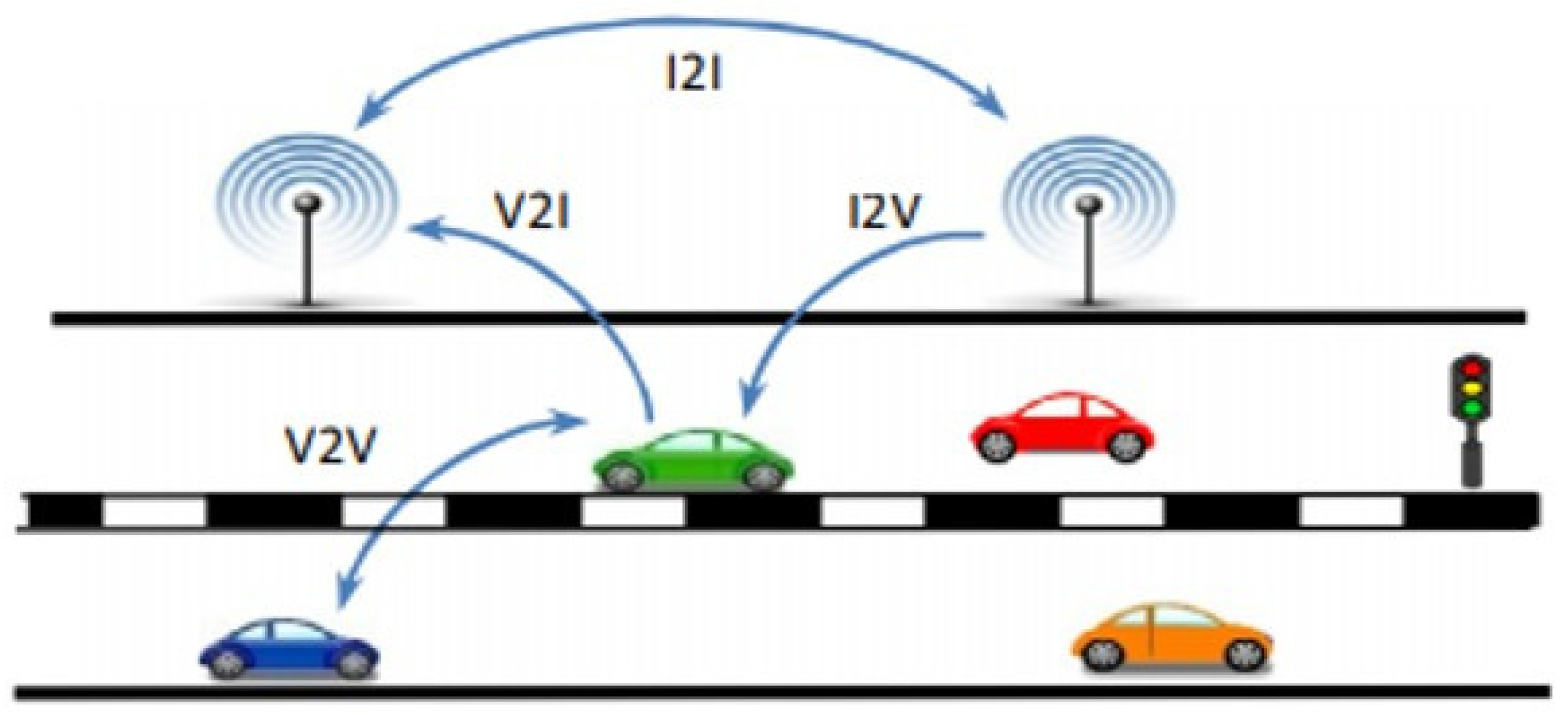
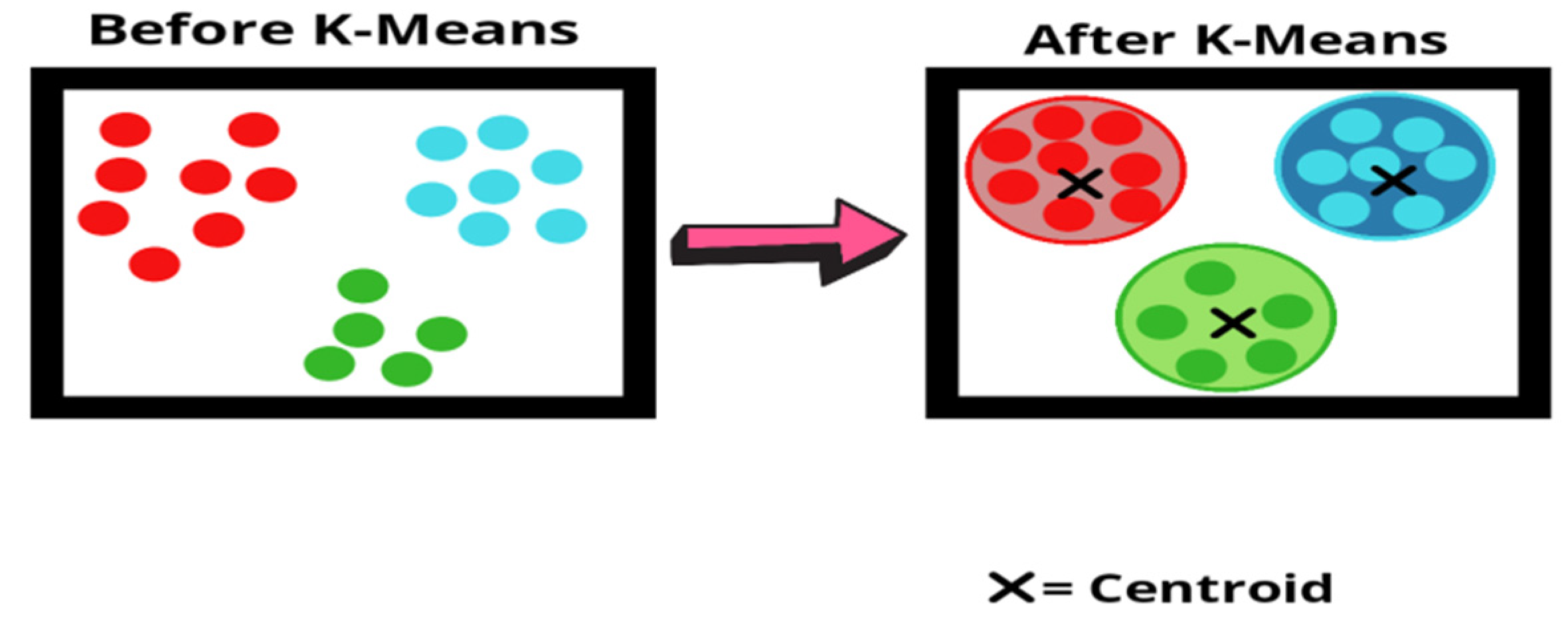

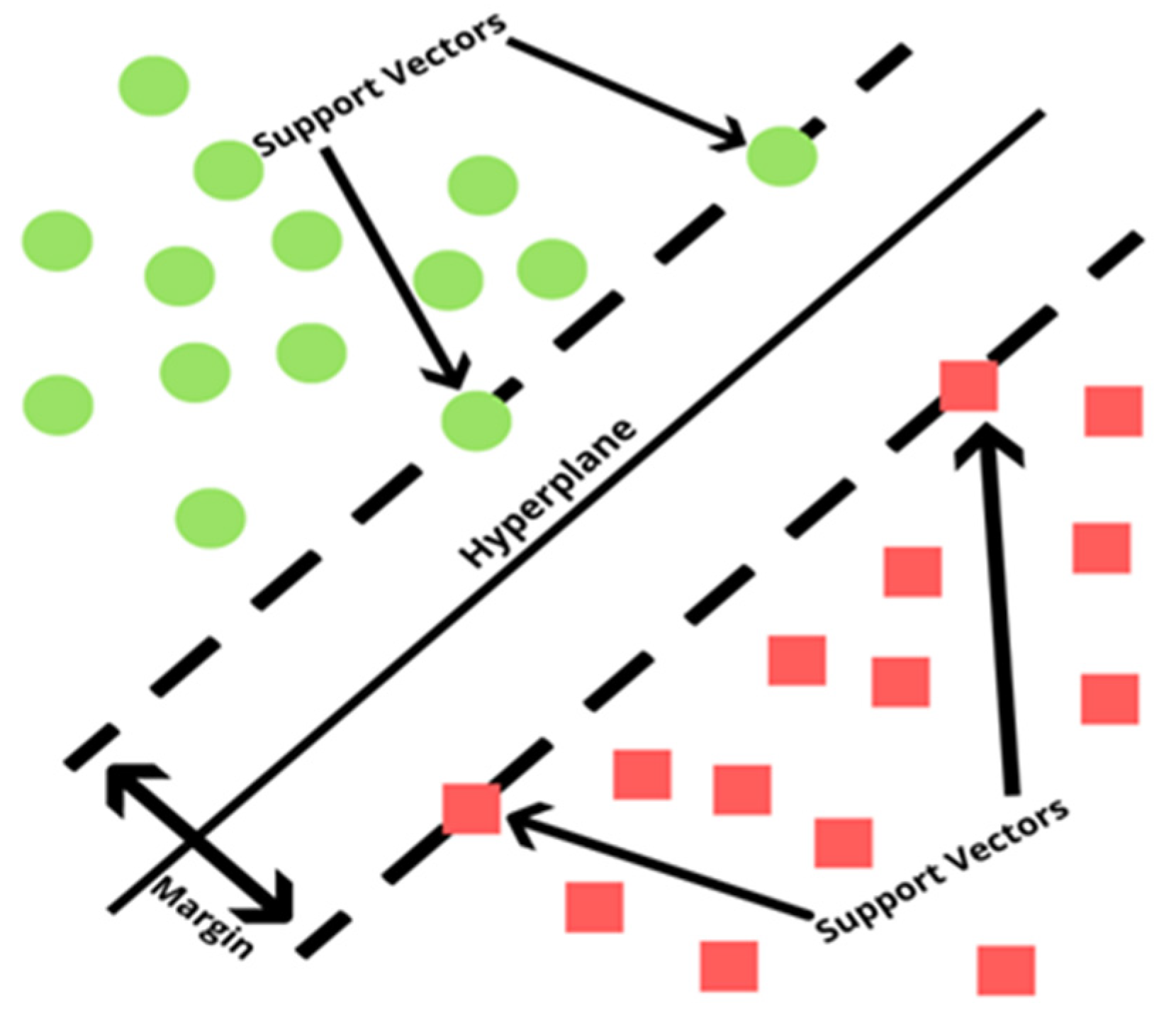

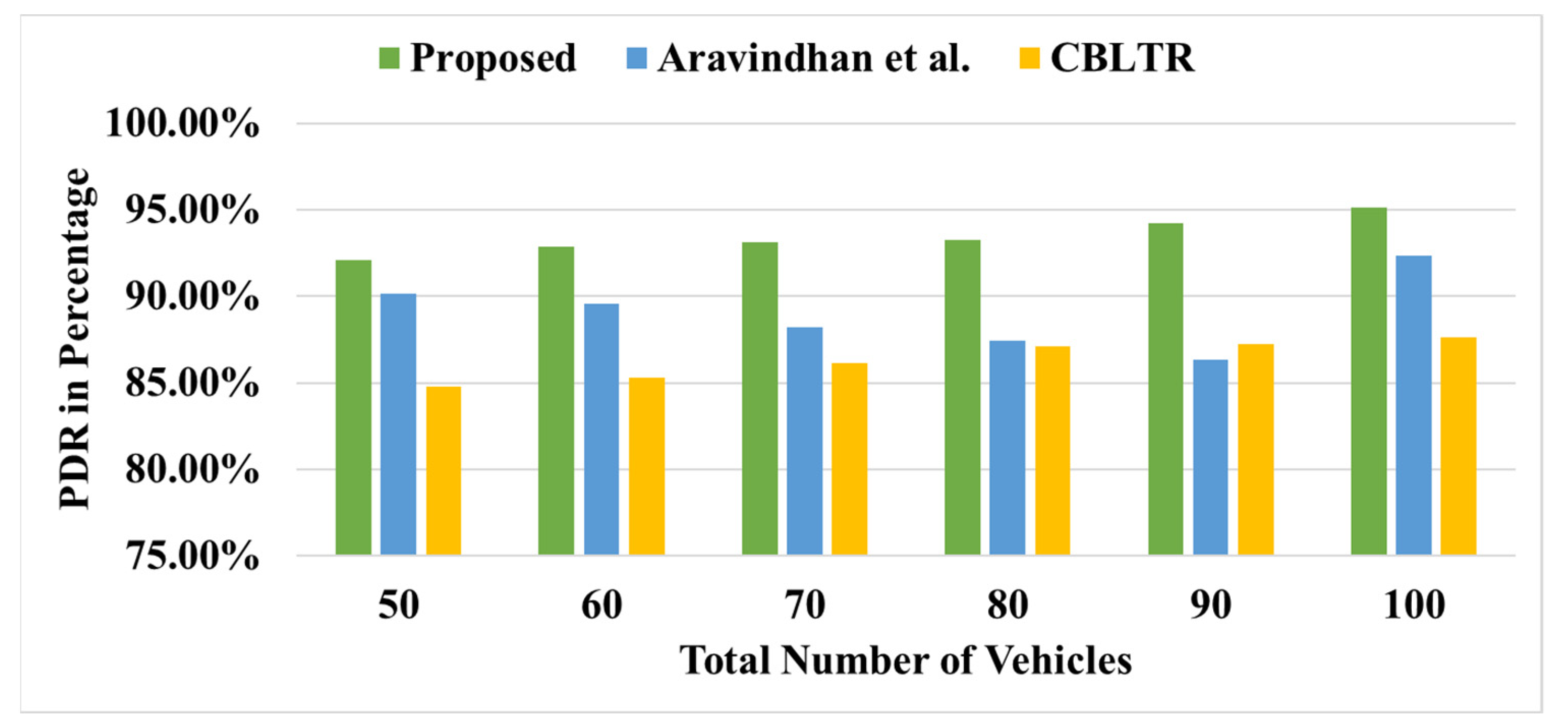

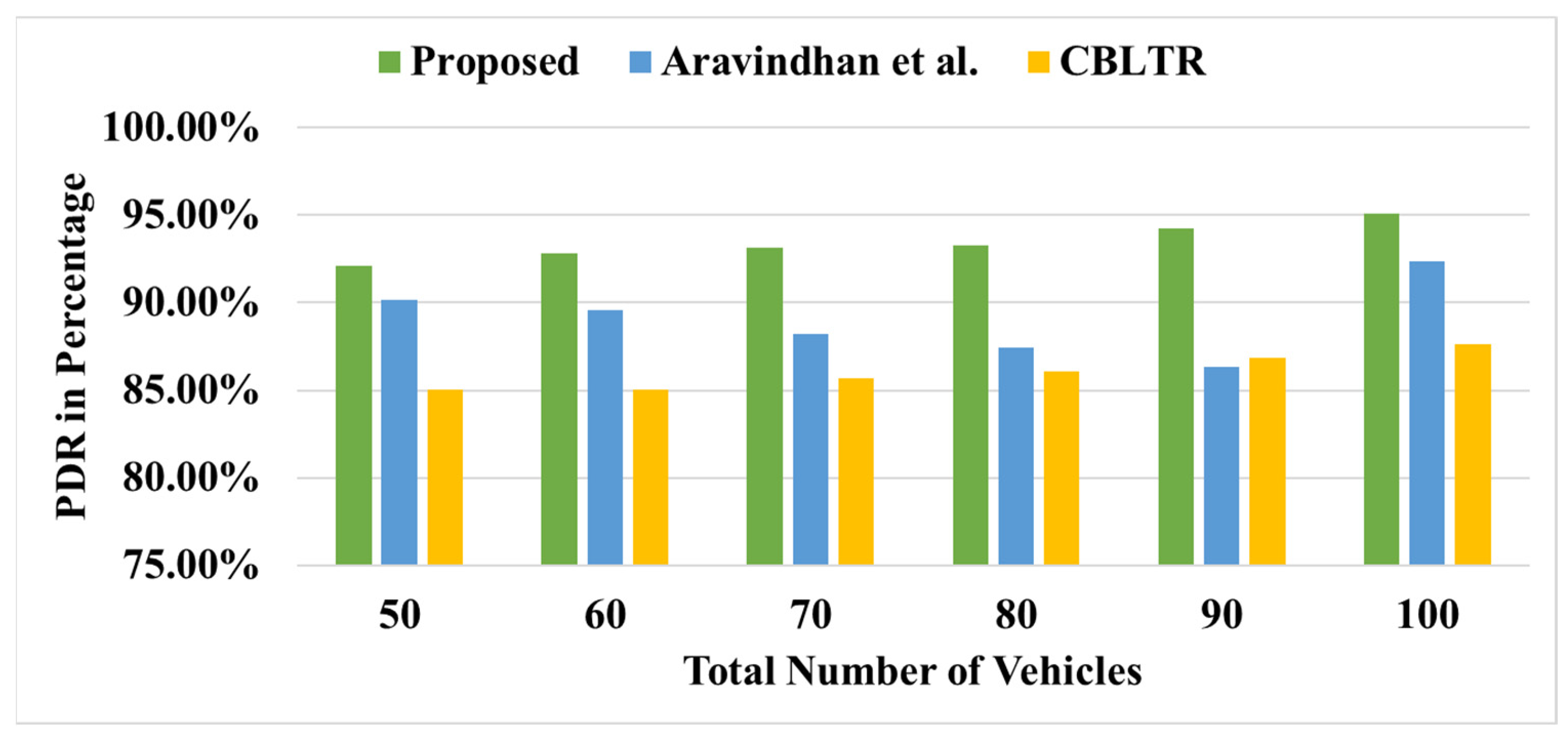

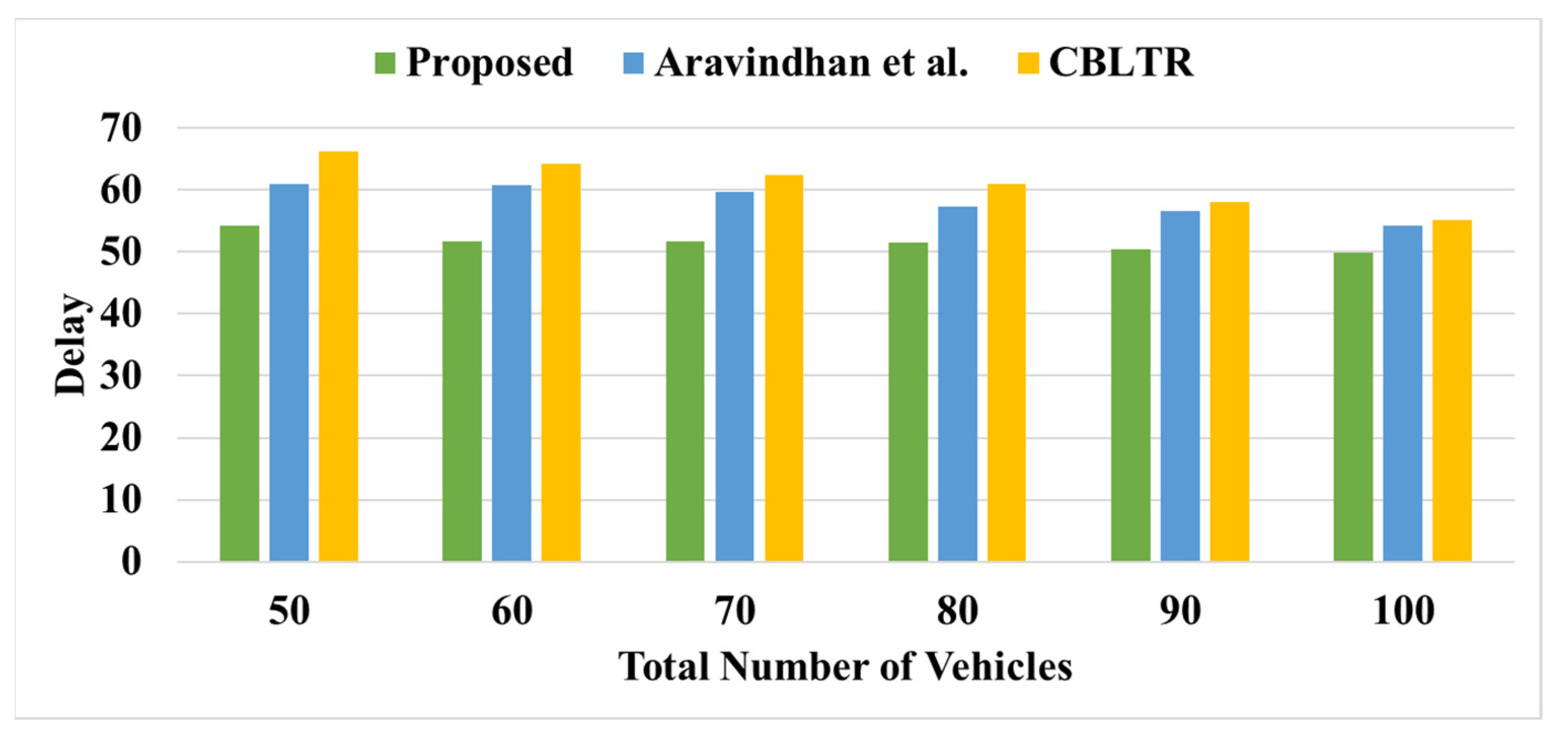
| Ref. ID. | Proposed Approach | Issues Addressed | Performance Parameters |
|---|---|---|---|
| [21] | Threshold-based clustering | Network instability to maximize the network efficiency | E2E delay and throughput |
| [22] | Artificial bee colony | Quality-of-service in VANET routing | E2E delay and PDR |
| [23] | Hybrid bee swarm | Timely dissemination of messages to improve road safety | Average E2E delay and PDR. |
| [24] | Weight-based | Delay constraints in VANET | Average E2E delay and PDR. |
| [25] | Ant colony Optimization | Effective bandwidth utilization, scalability, and robustness | E2E delay and PDR |
| [26] | Artificial bee colony | Find optimal routes based on QoS requirements | PDR, E2E delays, and the network overhead |
| [27] | Harmony search algorithm | Flexible routing due to the dynamic nature of VANET | PDR and network overhead |
| [28] | Particle swarm optimization | Scalability and overhead for routing | Delay, the routing load, dropped packets, throughput, and PDR |
| [29] | Support vector machine | Generate routing metrics to enhance reliability | Packet loss and network delay |
| [30] | Machine Learning | Reduce communication delays and enhance the stability of communications | PDRs and transmission delays. |
| [31] | Q-learning | Unreliability of the link due to vehicle movement | Package delivery rate and E2E delay |
| [32] | K-Harmonic Means | Multi-hop reliability and efficiency | Packet delivery rate |
| Simulation Parameter | Simulation Value |
|---|---|
| Simulation Time | 1000–5000 s |
| Area | 1000 × 1000 |
| Quantity of Vehicles | 50–100 |
| Transmission Range | 250 units |
| Vehicle velocity range | 10–60 kmph |
| Data packet | 1024 |
| MAC | 802.11 p |
| Maximum Speed | PDR | ||
|---|---|---|---|
| PDR Proposed | Aravindhan et al. [24] | CBLTR [21] | |
| 1 | 0.956 | 0.921147 | 0.881252 |
| 2 | 0.94114 | 0.91254 | 0.830825 |
| 3 | 0.89547 | 0.83254 | 0.776322 |
| 4 | 0.88471 | 0.85541 | 0.831066 |
| 5 | 0.831148 | 0.82146 | 0.731932 |
| 6 | 0.82114 | 0.80189 | 0.743047 |
| Total Number of Vehicles | PDR | ||
|---|---|---|---|
| PDR Proposed | Aravindhan et al. [24] | CBLTR [21] | |
| 50 | 0.92114 | 0.901458 | 0.84759 |
| 60 | 0.92847 | 0.89554 | 0.853078 |
| 70 | 0.93145 | 0.882145 | 0.861486 |
| 80 | 0.93259 | 0.87452 | 0.871304 |
| 90 | 0.942234 | 0.86325 | 0.872346 |
| 100 | 0.95112 | 0.923541 | 0.876269 |
| Total Number of Vehicles | PDR | ||
|---|---|---|---|
| PDR Proposed | Aravindhan et al. [24] | CBLTR [21] | |
| 50 | 0.92181 | 0.90114 | 0.847996 |
| 60 | 0.927007 | 0.910982 | 0.856946 |
| 70 | 0.932966 | 0.882145 | 0.857473 |
| 80 | 0.940004 | 0.87452 | 0.860932 |
| 90 | 0.943054 | 0.86325 | 0.868258 |
| 100 | 0.951186 | 0.923541 | 0.871627 |
| Total Number of Vehicles | PDR | ||
|---|---|---|---|
| PDR Proposed | Aravindhan et al. [24] | CBLTR [21] | |
| 50 | 0.92114 | 0.901458 | 0.850015 |
| 60 | 0.92847 | 0.89554 | 0.850314 |
| 70 | 0.93145 | 0.882145 | 0.857059 |
| 80 | 0.93259 | 0.87452 | 0.860566 |
| 90 | 0.942234 | 0.86325 | 0.868399 |
| 100 | 0.95112 | 0.923541 | 0.876087 |
Disclaimer/Publisher’s Note: The statements, opinions and data contained in all publications are solely those of the individual author(s) and contributor(s) and not of MDPI and/or the editor(s). MDPI and/or the editor(s) disclaim responsibility for any injury to people or property resulting from any ideas, methods, instructions or products referred to in the content. |
© 2023 by the authors. Licensee MDPI, Basel, Switzerland. This article is an open access article distributed under the terms and conditions of the Creative Commons Attribution (CC BY) license (https://creativecommons.org/licenses/by/4.0/).
Share and Cite
Sindhwani, M.; Sachdeva, S.; Gupta, A.; Tanwar, S.; Alqahtani, F.; Tolba, A.; Raboaca, M.S. A Novel Context-Aware Reliable Routing Protocol and SVM Implementation in Vehicular Area Networks. Mathematics 2023, 11, 514. https://doi.org/10.3390/math11030514
Sindhwani M, Sachdeva S, Gupta A, Tanwar S, Alqahtani F, Tolba A, Raboaca MS. A Novel Context-Aware Reliable Routing Protocol and SVM Implementation in Vehicular Area Networks. Mathematics. 2023; 11(3):514. https://doi.org/10.3390/math11030514
Chicago/Turabian StyleSindhwani, Manoj, Shippu Sachdeva, Akhil Gupta, Sudeep Tanwar, Fayez Alqahtani, Amr Tolba, and Maria Simona Raboaca. 2023. "A Novel Context-Aware Reliable Routing Protocol and SVM Implementation in Vehicular Area Networks" Mathematics 11, no. 3: 514. https://doi.org/10.3390/math11030514
APA StyleSindhwani, M., Sachdeva, S., Gupta, A., Tanwar, S., Alqahtani, F., Tolba, A., & Raboaca, M. S. (2023). A Novel Context-Aware Reliable Routing Protocol and SVM Implementation in Vehicular Area Networks. Mathematics, 11(3), 514. https://doi.org/10.3390/math11030514







